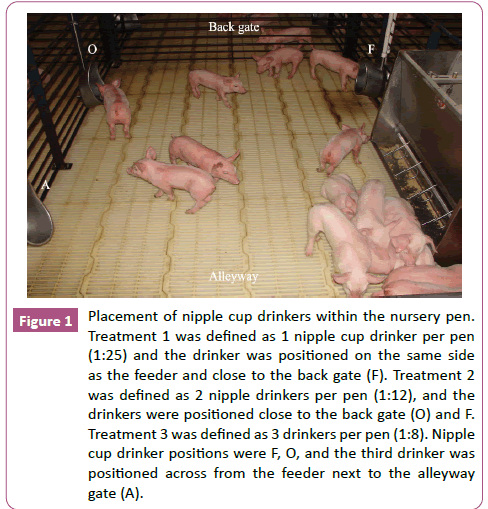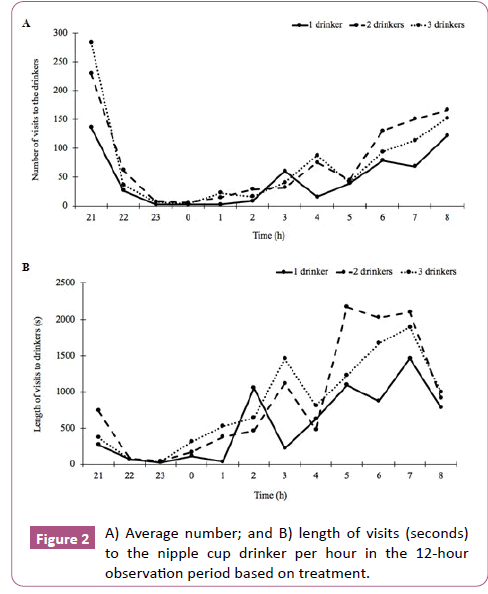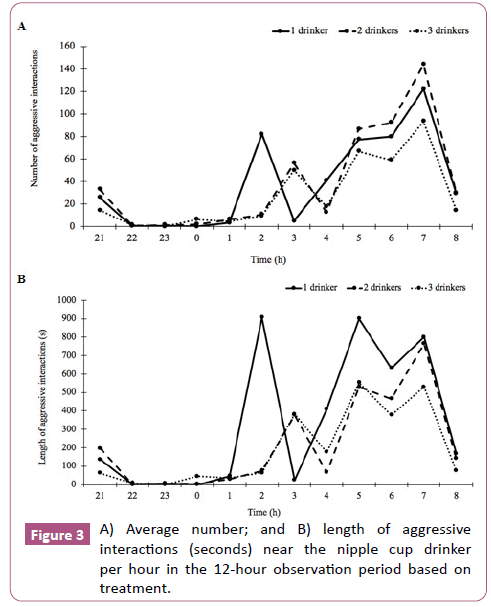Keywords
Behaviour; Pig; Water; Welfare
Introduction
Farm animals form a social hierarchy or rank order that can affect
accessibility to key resources within their pen including food
and water [1,2]. In competitive situations, more highly ranked
animals might have greater access to water and feed resources.
Therefore, middle to lower ranking animals could have greater
water accessibility if the producer considers water resource
placement strategy and the ratio of animals to water resource [3]. Anderson [4] considered water bowl number and location
for dairy cattle drinking behaviour and concluded that 2 bowls
were not better because they were too close. Deligeorgis et
al. [5] investigated drinker location (front right, front left, back
right, or back left) within farrowing stalls for piglet drinking
behaviour over the first 2 days of lactation. Newborn piglets
visited the drinker more during the day when compared to night
and piglets preferred drinkers that were positioned front right and back right (where the heat lamp was situated). However,
little published information exists in the scientific literature that
assesses the correct placement for key resources needed to
facilitate unhindered nursery pig drinking [6-8]. Many factors
should be considered when optimizing drinking availability [9].
One factor that is overlooked relates to the optimal pig-to-water
source ratio. Current recommendations are 1:10 [10], but there
is limited supporting science. Therefore, the study objectives
were to determine how 1, 2, or 3 drinkers per pen affected (1)
visit numbers and time spent at the drinker, and (2) aggressive
interactions in the drinker vicinity on placement day for nursery
pigs.
Materials and Methods
Housing and animals
This project was approved by the Iowa State University Animal
Care and Use Committee and conducted at a commercial nursery
facility in central Missouri. A total of 150 PIC crossbred (21 ± 4
days of age) gilts weighing 5.38 ± 2.65 kg were assigned to pens
by body weight. Piglets all came from the same sow farm, where
piglets during lactation had access to a stainless-steel nipple
water drinker right up to weaning. Each nursery pen measured
1.83 × 3.05 m, providing 0.22 m2/pig. Steel penning dividers were
3.05 m length × 91 cm height. Tenderfoot (Tandem Products, Inc,
Minneapolis, MN, USA) flooring was utilized in all pens and pigs
had ad-libitum access to a corn-soy diet formulated to meet or
exceed NRC requirements [11]. Diets were provided through a
5-hole stainless steel feeder 68.6 cm height × 91.4 cm length. The
building was curtain sided; the pigs received a natural light cycle.
Farm personnel observed all pigs at 0730 and 1530. Environmental
temperature was electronically recorded using data loggers
(Hobo Pro series, Forestry Supplies, Inc, Jackson, MS, USA). Each
data logger was suspended over each pen from the feed auger
at a height of 92 cm from the ground. Ambient temperature (°C)
and relative humidity (%) were recorded at 10-min intervals for
the duration of the trial. Environmental measurements averaged
28.84°C and 48.97% relative humidity (2100 [arrival] to 0900).
Treatments
A total of 6 pens were used (n=2 per treatment) with each pen
housing 25 pigs. Each pen contained 1, 2, or 3 stainless steel
nipple cup drinkers that measured 28.58 cm height × 17.78 cm
width (Farmweld DRIK-O-MAT Wean-to-Finish Cup, Farmweld,
Teutopolis, IL, USA). Treatment 1 was defined as 1 nipple cup
drinker per pen (1:25) and the drinker was positioned on the
same side as the feeder and close to the back gate (F). Treatment
2 was defined as 2 nipple drinkers per pen (1:12), and the drinkers
were positioned close to the back gate (O) and F. Treatment 3 was
defined as 3 drinkers per pen (1:8). Nipple cup drinker positions
were F, O, and the third drinker was positioned across from the
feeder next to the alleyway gate (Figure 1).
Figure 1 Placement of nipple cup drinkers within the nursery pen.
Treatment 1 was defined as 1 nipple cup drinker per pen
(1:25) and the drinker was positioned on the same side
as the feeder and close to the back gate (F). Treatment 2
was defined as 2 nipple drinkers per pen (1:12), and the
drinkers were positioned close to the back gate (O) and F.
Treatment 3 was defined as 3 drinkers per pen (1:8). Nipple
cup drinker positions were F, O, and the third drinker was
positioned across from the feeder next to the alleyway
gate (A).
Behavioural measures
Behaviour was recorded over 12 hours using a DVR (RECO-204,
Darim Vision Corp, Pleasanton, CA, USA) at 1 frame/s. One 12 V
black and white close circuit television camera (Model WV-CP484, Panasonic Matsushita Co Ltd, Kadmoa, Japan) was positioned
over each drinker and had the capacity of recording during
dark hours using infrared. Behavioural video acquisition was
collected in real time using the Observer software (The Observer,
Version 5.0.25 Noldus Information Technology, Wageningen, The
Netherlands). Four measures were collected at the individual pig
level; number and length of visits to the nipple cup drinker and
number and length of aggressive interactions in the vicinity of the
nipple cup drinker. A visit started each time the individual nursery
pig’s head was in the drinker and terminated when the pig’s head
moved out of the drinker for a period lasting 5 s or more [12].
Aggression in the vicinity of the drinker was defined as any fight,
bully, head-knock, or chase [13] which occurred in a radius of
0.61 m or less from the edge of the drinker. Data was collected by
an experienced observer and sorted by pen, treatment, and hour.
Averages were calculated per treatment for each hour in the 12-
hour observation period and data will be presented descriptively.
Results
Total number and length of visits to the nipple cup drinker were
greatest for treatment 2 (2 drinkers per pen; 1,894 ± 289 visits
and 21,413 ± 6,236 s), followed by treatment 3 (3 drinkers per
pen; 1,796 ± 47 visits and 20,065 ± 3,277 s). Pigs in pens with 1
nipple cup drinker had the lowest number of total visits (1,129
± 88) and the shortest visit length (13,277 ± 1,117 s). Hourly
averages per treatment for number and length of visits to the
nipple cup drinkers are depicted in Figure 2A and 2B. In the first
hour of placement (2100 to 2200), pigs in treatment pens with 2
or 3 nipple cup drinkers had more visits to the drinkers and pigs
in treatment pens with 2 nipple cup drinkers spent longer visiting
the drinkers. For the next 3 hours (2200 to 0100), regardless of treatment, there were very few visits with little time spent at
the drinkers. Between 0100 and 0900 for all treatments, the
number of visits to the drinker increased, however, there were
more visits with longer durations for pigs in treatment pens with
2 drinkers, followed by 3 drinkers per pen and then 1 drinker per
pen, respectively.
Figure 2 A) Average number; and B) length of visits (seconds) to the nipple cup drinker per hour in the 12-hour observation period based on treatment.
The total number of aggressive interactions near the drinker
was greatest for treatment 2 pens (2 drinkers per pen; 954 ±
379 interactions), followed by treatment 1 pens (1 drinker per
pen; 936 ± 151 interactions). Pigs in pens with 1 drinker spent
more time involved in aggressive interactions near the water
source (8,060 ± 375 s), followed by pens with 2 drinkers (5,307 ±
2,374 s). Pigs in treatment pens given 3 drinkers had the lowest
total number (676 ± 269 interactions) and the shortest length
(4,614 ± 1,912 s) of aggressive interactions in the vicinity of the
drinkers. Hourly averages per treatment for number and length of
aggressive interactions near the nipple cup drinkers are depicted
in Figure 3A and 3B. In the first hour of placement (2100 to 2200),
pigs in treatment pens with 1 or 2 drinkers had more and longer
aggressive interactions around the drinker vicinity. For the next 3
hours (2200 to 0100), regardless of treatment, there were very
few aggressive interactions in the drinker vicinity. From 0200 to
0300, pigs in treatment pens with 1 drinker per pen had more
and longer aggressive interactions than pigs with 2 and 3 drinkers
per pen. Pigs in pens with 3 drinkers had fewer and shorter
aggressive interactions in the drinker vicinity from 0400 to 0900,
respectively.
Figure 3 A) Average number; and B) length of aggressive interactions (seconds) near the nipple cup drinker
per hour in the 12-hour observation period based on
treatment.
Discussion
Nursery pigs experience numerous stressors during weaning, for example, abrupt sow separation, close human contact,
transportation, a different physical environment, dietary change,
and social mixing [14-16]. Nursery pig drinking research is
important because it effects growth, weight, health, welfare,
and overall profit. Drinking behaviour develops the first few days
after pigs are mixed and placed in pens with their new cohorts
when the net absorption of fluid and electrolytes is temporarily
decreased [14,17].
Typical drinker types used for nursery pigs include: bowl, nipple,
or push-levers [9]. From the present study, pigs offered multiple
drinkers per pen visited more often and spent more time drinking
whilst experiencing shorter aggressive interactions. These findings
agree with Turner et al. [12] who reported more drinker-related
aggression when a 1:20 drinker to pig ratio was allocated to the
pen when compared to pens of pigs where the drinker to pig ratio
was 1:10. Interestingly, pig’s offered 2 drinkers had the greatest
number of aggressive interactions near the nipple cup drinker.
However, there were only 2 pens per treatment and there was
a large variation in aggressive interaction number between the
pens. Hence, this variation could be due to differences in social
hierarchies in these pens [2]. Additionally, not all of the drinkers
might have been considered equal due to their location, i.e. air
flow, leakage, dunging areas, human interference, or inter-pen
pig interaction [9]. Further work could evaluate whether pigs
show a location preference for drinker placement within the pen.
When parcelling out hours for the number and length of visits and
aggressive interactions, there was an initial peak in the first hour
after placement followed by a minimum plateau until 0200. A
secondary peak occurred from 0200 to 0400 with an even greater peak from 0500 to 0700. These behavioural peaks could be due
to circadian drinking rhythms [18], temperature [19], establishing
social order [2], and feeding and drinking relationships [20].
Although feeding related activities were not collected it has been
well documented that pigs are prandial feeders-drinkers [21,22].
Conclusion
In conclusion, aggressive behaviour on placement day was
reduced in pens of pigs where multiple drinkers per pen were
utilized and provided a lower drinker to pig ratio. This work adds
to the limited information in the published literature to help
producers with water resource placement within a nursery pen.
Acknowledgements
Support was provided by Boehringer Ingelheim Vetmedica, Iowa
Farm Bureau Federation, and Iowa State University Department
of Animal Science. Thanks to Cargill Pork for use of their facilities
and care of the animals, Jill Garvey, and Tony Uhlenkamp for
technical assistance.
References
- Estevez I, Andersen I, Naevdal E (2007) Group size, density and social dynamics in farm animals. Appl Anim Behav Sci 103: 185-204.
- Fels M, Hartung J, Hoy S (2014) Social hierarchy formation in piglets mixed in different group compositions after weaning. Appl Anim Behav Sci 152: 17-22.
- Anderson JA, Lindgren K (1987) Effects of restricted access to drinking at feeding and social rank on performance and behaviour of tied up dairy cows. Swed J Agric Res 17: 77-83.
- Anderson M (1987) Effects of number and location of water bowls and social rank on drinking behaviour and performance of loose-housed dairy cows. Appl Anim Behav Sci 17: 19-31.
- Deligeorgis SG, Karalis K, Kanzouros G (2006) The influence of drinker location and colour in drinking behaviour and water intake of newborn pigs under hot environments. Appl Anim Behav Sci 96: 233-244.
- Olsson O (1983) Evaluation of bite drinkers for fattening pigs. Tans Am Soc Agric Eng 26: 1495-1498.
- Phillips PA, Fraser D (1990) Water bowl size for newborn pigs. Am Soc Agric Eng 6: 79-81.
- Phillips PA, Fraser D, Pawluczuk B (2001) Determining the optimum mounting of water nipples for sows. Am Soc Agric Eng 17: 845-847.
- Azarpajouh S, Garcia A, Jackson C, Karriker L, Ramirez A, et al. (2018) The importance of water in pig production. CAB Reviews 13: 1-17.
- PIC (2014) Wean to Finish Manual. Retrieved on 11 September 2019, from http://na.picgenus.com/sites/genuspic_com/Uploads/Wean%20To%20Finish%20Manual.pdf.
- National Research Council (1998) Water. In: Nutrient Requirements of Swine. Washington DC: National Academy of Sciences, pp: 90-95.
- Turner SP, Edwards SA, Bland VC (1999) The influence of drinker allocation and group size on the drinking behaviour, welfare and production of growing pigs. J Anim Sci 68: 617-624.
- D Eath RB (2002) Individual aggressiveness measured in a resident-intruder test predicts the persistence of aggressive behaviour and weight gain of young pigs after mixing. Appl Anim Behav Sci 77: 267-283.
- Dybkjaer L, Jacobsen AP, Togersen FA, Poulsen HD (2006) Eating and drinking activity of newly weaned piglets: effects of individual characteristics, social mixing, and addition of extra zinc to the feed. J Anim Sci 84: 702-711.
- Campbell JM, Crenshaw JD, Polo J (2013) The biological stress of early weaned piglets. J Anim Sci Biotechnol 4: 19.
- Ellis M, De Decker J (2019) Management of large groups of growing pigs. Retrieved on 11 September 2019, from https://swine.extension.org/management-of-large-groups-of-growing-pigs/.
- Nabuurs MJA, Hoogendoorn A, Van Zijderveld FG (1994) Effects of weaning and enterotoxigenic Escherichia coli on net absorption in the small intestine of pigs. Res Vet Sci 56: 379-385.
- Rossi R, Del Prete E, Rokitzky J, Scharrer E (1999) Circadian drinking during ad libitum and restricted feeding in pygmy goats. Appl Anim Behav Sci 61: 252-261.
- Brumm MC (2006) Patterns of drinking water use in pork production facilities. In: Nebraska Swine Report Publication EC 06-219. Lincoln: University of Nebraska.
- Yang TS, Howard B, Mc Farlane WV (1981) Effects of food on drinking behaviour of growing pigs. Appl Anim Ethol 7: 259-270.
- Bigelow JA, Houpt TR (1988) Feeding and drinking patterns in young pigs. Physiol Behav 43: 99-109.
- Barber JP, Brooks PH, Carpenter JL (1989) The effects of water delivery rate on the voluntary food intake, water use and performance of early-weaned pigs from 3 to 6 weeks of age. In: Forbes JM, Varley MA, Lawrence TLJ, editors. The Voluntary Feed Intake of Pigs. Edinburgh: British Soct Anm Prod 103-104.




